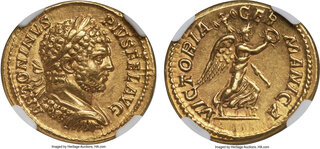| Heritage World Coin Auctions > CSNS Signature Sale 3115 | Auction date: 8 May 2024 |
| Lot number: 31094 Price realized: This lot is for sale in an upcoming auction - Bid on this lot  | Show similar lots on CoinArchives Find similar lots in upcoming auctions on |
| Lot description: Ancients Caracalla (AD 198-217). AV aureus (20mm, 6.78 gm, 12h). NGC Choice XF 5/5 - 3/5, edge filing. Rome, AD 213. ANTONINVS-PIVS FEL AVG, laureate, cuirassed bust of Caracalla right, seen from behind / VICTORIA-GER-MANICA, Victory advancing right, with wreath in outstretched right hand, trophy cradled in left arm. Calicó 2833. RIC IV.I 237 var. (slight drapery). Very rare type with 10 other specimens in sales archives. An exquisite offering adorned with areas of amber toning, complemented by fields that radiate an enchanting brilliance. Ex Bertolami Fine Arts-ACR Auctions, Auction 87 (14 December 2020), lot 561; Numismatica Ars Classica, Auction 97(12 December 2016), lot 188; Hess-Divo, Auction 327 (22 October 2014), lot 131. This exquisite and rare aureus tries to tell us a tale of a triumphant emperor and his successful war, when in fact it heralds a broader era of decline for the Roman Empire known as the Migration Period. In February 213 AD, the Alemanni broke through the frontier fortifications in Germania (Limes Germanicus) into the province of Rhaetia. Caracalla departed Rome soon after: his departure (profectio) to the frontier is also commemorated on coinage in the same year. During this campaign the emperor, whose birth name was Marcus Aurelius Antoninus, began wearing a Germanic hooded cloak (caracallus), from which he derived his nickname, Caracalla. The Romans massacred as many of the Alemanni as they could manage, but the war still ended in a stalemate. Caracalla was then compelled to pay the Germanic tribes tribute in return for halting their incursions. An altogether unique triumphal monument-the Limestor Dalkingen in Bavaria, Germany-was erected at the site of the breach in the Limes and was surmounted by a colossal bronze statue of the emperor. The Roman biographer Cassius Dio, a contemporary of Caracalla, reflected that the whole conflict was likely devised by the new emperor as a guaranteed way of acquiring military prestige, remarking that "He published outright to the world some of his basest deeds, as if they were excellent and praiseworthy". It was undoubtedly Caracalla's intention to link his own victory in Germania with Trajan's success in the Dacian Wars, as the same legion was used in both campaigns. Trajan had received the title Germanicus by the time he became emperor, and after the Alemannic campaign, Caracalla likewise took Germanicus Maximus. Some historical sources even claim that he adopted the title Alamannicus. Caracalla's Alemannic War marks the beginning of the fall of the Limes, a historical period that saw the Romans abandon their fortifications (castra) and withdraw troops from the Rhine and the Danube. The residents of the borderland were aware of the effects of this crisis--dismantled castra and the abundance of hoards illustrates a mood of panic in the archaeological record. Service in the auxiliary troops, which had provided guard duty on the Limes, became unattractive as a result of the Edict of Caracalla (Constitutio Antoniniana), as it had removed one of the main incentives for military service: Roman citizenship. As a result of the fall of the Limes, which must have occurred in the mid-3rd century, Germanic tribes were able to settle in the unprotected area then called Alemannia by the Romans. https://coins.ha.com/itm/ancients/roman-imperial/ancients-caracalla-ad-198-217-av-aureus-20mm-678-gm-12h-ngc-choice-xf-5-5-3-5-edge-filing/a/3115-31094.s?type=DA-DMC-CoinArchives-WorldCoins-3115-05082024 HID02906262019 © 2024 Heritage Auctions | All Rights Reserved Estimate: 10000-12000 USD |  |



